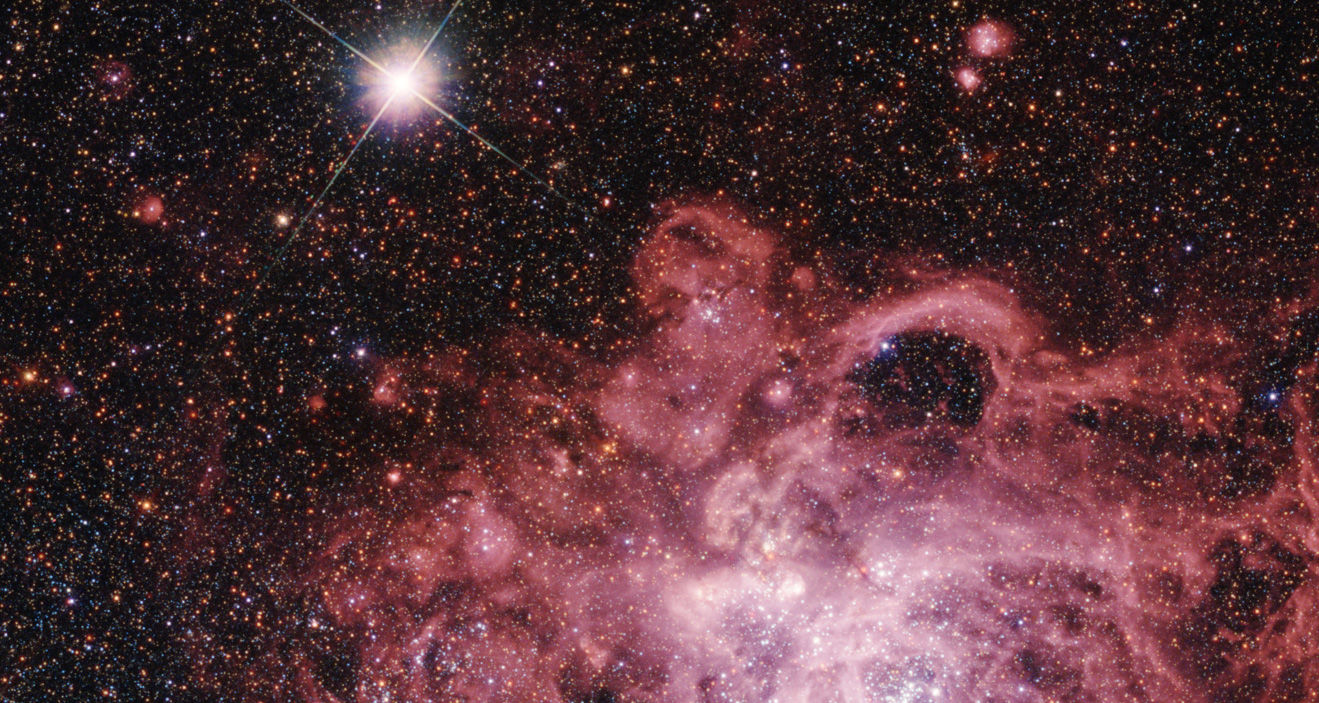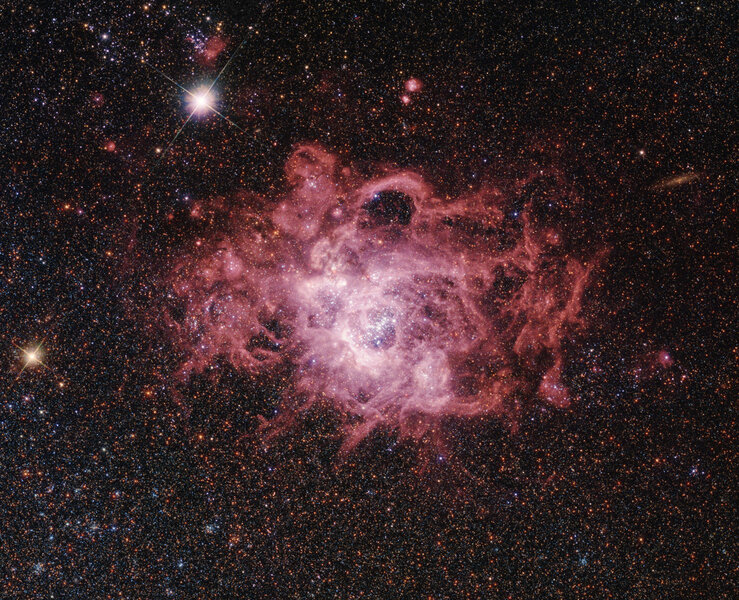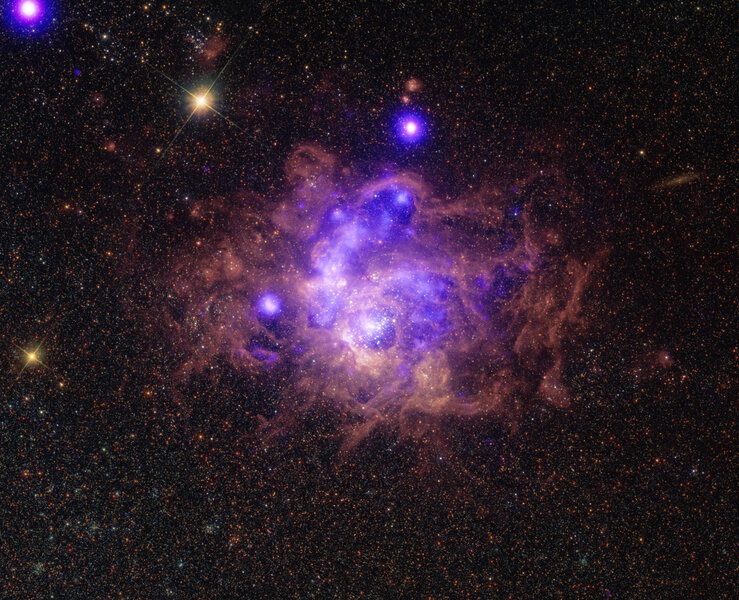Create a free profile to get unlimited access to exclusive videos, sweepstakes, and more!
M33 Followup: The massive and fierce beauty of an enormous stellar nursery

Yesterday, I wrote about the magnificent Hubble mosaic of the nearby galaxy M33, aka the Triangulum Galaxy. This face-on spiral is an understated wonder, faint by eye, but close enough that Hubble reveals treasures.
One of the jewels inside it is NGC 604, which I described briefly in the article. I didn't go into much detail on this nebula for two reasons: One is that it wasn't the main thrust of the article and I didn't want to wander off too much, and the other is that the nebula looks weird in the image — only two filters were used to create the released image, and so the nebula appears vividly blue. But... the nebula is most certainly not blue.
See for yourself. Here's the spectacular NGC 604 with a far better color balance:
Oh yeah.
This image was created by Judy Schmidt, whose work taking raw Hubble data and turning them into astonishing art has been featured here on the blog many times. Her Flickr page is basically one wonder after another.
For scientific research, the Hubble observations of M33 were done in multiple filters, but only two were used in the release image. Schmidt took images from the other filters used, plus Hubble observations of NGC 604 taken years ago, and assembled them into that amazing image. The colors are not "natural", in that what you see as red isn't from red light. Instead, what's displayed as red is from near-infrared light, just outside what our eyes can see. Green is from red light, cyan from blue-green, and blue from (shockingly) blue. She also added a layer from filters that selected out light emitted by warm hydrogen, which is displayed as pink. Since hydrogen is the most abundant element in this gas — and also one of the strongest emitters of light — the nebula appears strongly red.
This is perhaps my favorite nebula in the sky; besides its stunning beauty it's physical characteristics overwhelm the brain. For one, despite the detail and clarity of the image, the distance to this object is staggering; M33 is about 2.7 million light years away, so the light you see in this image left NGC 604 when our closest ancestor walking the Earth were the australopithecines, which had just recently started walking upright.
NGC 604 is also a monster. It's over 1,500 light years across, a crushing number. The famous Orion Nebula, bright enough to see with the naked eye, is about 25 light years across. It's bright because it's close to us, about 1,300 light years distant — NGC 604 is over 2,000 times farther away. Were you two swap the two, NGC 604 would shine nearly as bright as Venus (!!), while Orion would be just another faint pink patch in M33 among many hundreds of others.
The nebula is massive as well, with something like 100,000 times the mass of the Sun total. That can make a lot of stars, and in fact there's a luminous cluster in its center with many thousands of stars in it.
Speaking of which, Schmidt did something interesting with this image as well: She added data taken using the Chandra X-Ray Observatory to it. X-rays are emitted by a lot of different objects, and in this case it comes from extremely hot gas at a temperature of over a million degrees! What does the nebula look like when you add that in?
This:
Ooo, isn't that pretty? The underlying image is the same, but the purple shows the hot X-ray emitting gas. If you look carefully, you'll notice the hot gas appears to be filling the empty regions of the nebula, where there's not as much cooler gas… and that is actually the case. Hot, young, massive stars in the nebula expel tremendous winds, like the Sun's solar wind but thousands of times more powerful. This material expands and pushes against the surrounding gas, blowing huge bubbles dozens of even hundreds of light years across.
Can I take a moment and say holy yikes. The amount of sheer power on display there is soul-chilling. We're talking about a vast amount of material, octillions of tons of it, getting swept up by these stellar winds like a snowplow driving through fresh winter precipitation. And it's being moved hundreds of trillions of kilometers!
Like I said: Soul-chilling.
Anyway, the X-ray data reveal something interesting. On the west side of the nebula (below center in the image) the hot gas adds up to about 4,500 times the Sun's mass. The energy it contains is supplied by the hot stars in the center, needing about 200 of the most massive ones to pump it up. The east side (toward the top) has less of that hot gas, maybe 1,750 times the Sun's mass. The energy it gives off, though, can't be accounted for using just stars to heat it. It's likely that several of the massive stars on the east side of the nebula have exploded as supernovae sometime in the past, adding their energy to the gas.
By the way, the bright X-ray source just above the nebula is a distant background galaxy, its supermassive central black hole greedily gobbling down matter and heating it up to millions of degrees. The bright splotch in the nebula to the left is a supernova remnant, the expanding debris from an exploded star. The very bright X-ray source at the very top left is a mystery; I poked through some catalogs and just found it listed as an X-ray source, which isn't helpful. But given how bright it is, I suspect it's an X-ray binary in M33, a black hole or neutron star tearing material off a low-mass star. As the material spirals in it heats up and glows, a mini version of what's going on in that background galaxy.
All in all, wow. A Hubble image of this nebula was released in the 1990s, and the filter combination made it look green, oddly enough. I've been waiting a long, long time for a higher resolution image using proper color balance, and I'm very grateful to Judy for putting her expert touch on this ridiculously beautiful object. I loved it before, but I appreciate it even more now.
Follow Judy Schmidt on Twitter for updates on her amazing and lovely work.
















